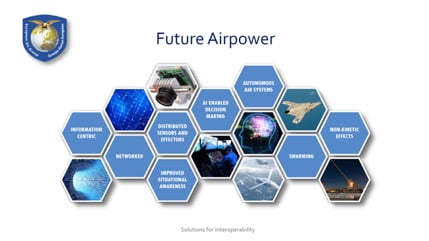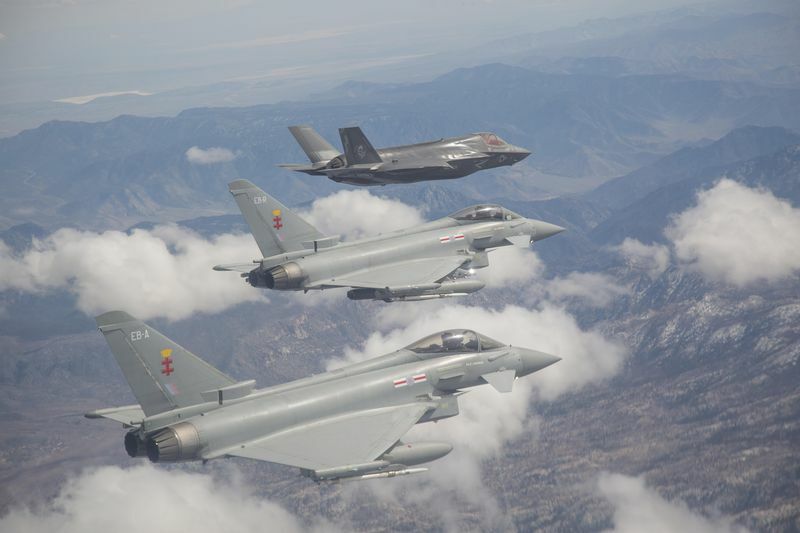By Robbin Laird
The European Air Group has been an incubator for change within the European air forces. The EAG flies below the radar but is a key asset for the Air Chiefs of 7 major European Air Forces in shaping ways to work more effectively together and to get the best value they have from legacy and new assets at the disposal of those forces.
They clearly have grasped the point of the Ben Franklin moment: We all hang together or we hang separately!
“We need to learn to work more effectively together to ensure that our individual national air capabilities are maximized in their effectiveness,” as one EAG official told me a few years ago.

The head of the EAG is rotational among the Air Chiefs, with the current COS of the Italian Air Force now the head of EAG. The Chiefs meet once a year to shape an agenda and to determine the way ahead based on the work performed by the EAG or being shaped for the EAG. There is a small permanent staff, headed by a Deputy Director and a Chief of Staff for the EAG, with its headquarters at RAF High Wycombe, UK.
The seven European Air Forces involved in the EAG are the following: the UK, France, Italy, the Netherlands, Belgium, Spain and Germany.
Two notable achievements of the EAG are working through the terms of reference and the approach to establishing the European Air Transport Command and the European Personnel Recovery Centre.
In 2014, I first visited the EAG and presented a briefing on how to think about the integration of 4th and 5th generation aircraft as European airpower is transformed under the impact of fifth generation operations.
http://www.euroairgroup.org/project/4th5th-gen-aircraft-integration-initiative/
In 2016, the EAG held a working group session and conference on the opportunities and challenges with leveraging fifth generation transformation.
The 2016 two-day 4th 5th Generation Integration Information Forum was held at the home of the EAG, RAF High Wycombe, at the end of April 2016.
With national 5th Generation aircraft programs maturing and the need to integrate 4th and 5th generation aircraft into future coalitions acknowledged the forum is providing a vital conduit to keep information flowing between both EAG nations and external partners and increase the awareness of nations about the challenges to come.
The first day saw experts from academia and industry set the scene with their interpretation of the technological and political developments that are going to shape the future of air power and more specifically the challenges of integrating 4th and 5th generation multi-national air forces into that vision.
The second day opened the floor to a discussion between the individual EAG nations present, Tactical Leadership Program (TLP), Joint Air Power Competence Centre (JAPCC); European Union Military Staff (EUMS) and the USAF that was being represented for the first time at an EAG 4th 5th Generation Forum.
The debate focused on the specific challenges being experienced at a national program level whilst also providing an overview of the future Air Force compositions.

The identification of the common challenges being experienced with this cutting edge evolution of the approach to, and employment of, air power is key to the development of future collaborative solutions.
National representatives were able to take away key areas for further consideration and investigation that when resolved will be fundamental to enhancing interoperability between the nations.
The 4th 5th Generation Integration Information Forum will continue to provide a crucial communication channel between the EAG nations as the next generation of combat aircraft are brought into service in Europe.
http://www.euroairgroup.org/project/4th-5th-generation-integration-information-forum-april-2016/
Since then, the work on 4th 5th Gen integration has progressed considerably and the Integration Forum has been absorbed within a dedicated program that has been launched by the EAG in 2017.
During my most recent visit to the EAG in February 2018, I had a chance to talk with the Deputy Director of the EAG, Air Commodore Robert Adang of the Royal Netherlands Air Force, and to get an update on the effort to leverage fifth generation capabilities.
http://www.euroairgroup.org/wp-content/uploads/20161114-Bio-Cdre-Adang-DDEAG.pdf
As he noted in our discussion, as a young student he saw the first F-16 ever to visit the Netherlands fly over his school and head for a Dutch Air Base. Now, he is on the ground floor as the F-35 enters European Air Forces, and is a force for change in reshaping the overall concepts of operations and combat capabilities of European Air Forces.
The EAG is addressing the question of how to shape an interoperable 4th-5th generation air force. They are addressing the question of “interoperability gaps” and how to attenuate them.
The EAG has developed a program, which they call the Combined Air Interoperability Program (CAIP) guiding the overall effort. The EAG Steering Group mandated in 2016 that there was a need “to develop a plan to solve the inte

roperability challenges that result from integrating 5th Gen with 4th Gen systems.”
The EAG is clearly not working this alone but is also providing operational intellectual capital to core organizations working the challenge in Europe, including USAFE, the Joint Air Power Competence Centre and NATO HQ Air Command.
As Air Commodore Adang put it: “the objective is plain and simple. It’s to create the optimum conditions for future combined training, exercise and operations by resolving interoperability issues that result from 4th and 5th gen integration.”
The baseline point is that F-35s will be a part of the force but not the dominant part numerically.
As Adang underscored: If I look at European air forces, current plans, when you total the projected number of F-35s in about ten years’ time, say 2028, and you compare it to the number of 4th gen fighters that will be used at that time still, then you’re looking at about 20% fifth gen systems and 80% 4th gen systems, not including any F-35 or F-22 US forces.
“And the total number that makes up that 20% of F-35s is too small to create the total effects that you need in a major combined air operation.
“You need the missile carrying capabilities and other attributes of the 4th gen fighters to ultimately be successful. So it’s only through a combination of 4th and 5th gen that we can be successful in future air operations.
“And this is the trick.”
Several dynamics of change are being addressed to generate a transformation process.
The first is shaping new training capabilities.
“How do we integrate the F-35 in the European theatre? We’re working on that between the nations and associated organizations.
“How can we establish red forces capability that’s relevant for a 5th gen force?”
The second is to build out airspace training ranges within Europe as well.
“There is a clear need for training airspace and ranges that are suitable for accommodating training with 5th gen weapon systems.”
The capabilities of the fifth-generation sensors and how the sensor-shooter relationship will operate over larger areas of airspace clearly requires reworking airspace training options. And to do so will require working with the civilian authorities responsible for handling the common airspace.
“When you’ve identified this common idea of where these chunks of training airspace are going to be, then you have to start looking at how that aligns with Single European skies. It’s the aim of Single European Skies to optimize civilian air transport. Integrating military training airspace is not a primary objective, and needs to be addressed effectively.
Third, is working the synthetic training environment and cross linking the various European efforts, including reaching out to the US forces in Europe as well.
“When I look at synthetic training, what I see is these national networks being developed bit by bit. I see some initiatives to connecting F-35 simulators multinationally. We clearly need to have some multinational training network that enables interoperability training in a synthetic environment – or rather a live, virtual and blended environment – in addition to live training.
“And I think that from a technological point of view it will be relatively easy to connect F-35 simulators from different nations in a multinational network, but then connecting that network to 4th gen capabilities for 4th gen nations is going to be where the challenge is, not only because of technological differences but also from a security perspective. But in the end, that’s where we have to go.
“If in ten or fifteen years’ time, we don’t do a substantial part of our multinational training in a synthetic environment, we’ve done something wrong.”
More broadly speaking with regard to transformation, the European air combat fleet under the impact of fifth generation is forcing changes, which are congruent with where technology, C2 and concepts of operations are headed.
Air Commodore Adang treats the F-35 as a first-generation information dominance aircraft. The fifth-generation approach lays the foundation for preparing for the future while current capabilities are transformed as well.
“By now most people agree there’s a future of military operations come to be about information, not about systems. And the only way to be successful in these information-centric operations is when all the capabilities that you have are networked together seamlessly, or as seamless as possible. And those networks will see an increasing number of distributed centers and effectors operating in unison through the network. These sensors will give us an improved situational awareness if we prove to be capable of exploiting all the information that they’re gathering, that’s one of the biggest challenges that we will be facing in the future.”
Put simply: a different approach to airpower and the fifth generation transformation is clearly driving change in this direction and the EAG wants to both help shape a way ahead for integration of the legacy with the new fleet, but lay down the foundation for the kind of combat learning which such a 21st century air combat foundation can enable.
“How can we educate people in 5th gen awareness, make them aware what 5th gen warfare means?”
The EAG is working within a network of organizations to foster innovation and to provide cross organizational learning which can facilitate transformation as well. “We want to take the best ideas and approaches within the European airpower network and apply those throughout the European airpower system.”
In short, the EAG is proving pragmatic intellectual leadership in the European airpower environment to shape a way ahead for a more capable 21st century combat force.


